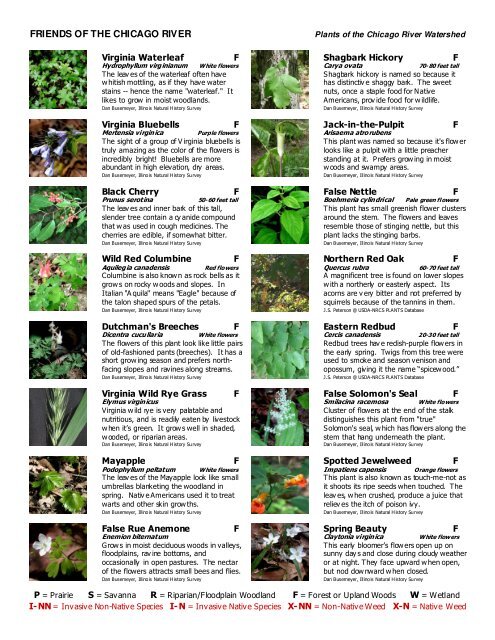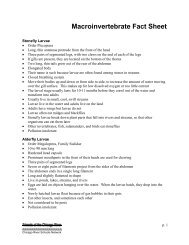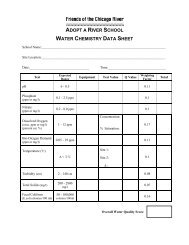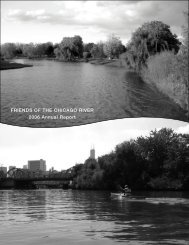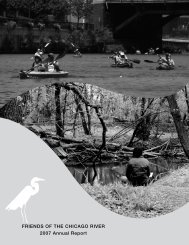Forest and Woodland Invasives - Friends of the Chicago River
Forest and Woodland Invasives - Friends of the Chicago River
Forest and Woodland Invasives - Friends of the Chicago River
Create successful ePaper yourself
Turn your PDF publications into a flip-book with our unique Google optimized e-Paper software.
FRIENDS OF THE CHICAGO RIVER Plants <strong>of</strong> <strong>the</strong> <strong>Chicago</strong> <strong>River</strong> Watershed<br />
Virginia Waterleaf F<br />
Hydrophyllum virginianum White flowers<br />
The leav es <strong>of</strong> <strong>the</strong> waterleaf <strong>of</strong>ten have<br />
w hitish mottling, as if <strong>the</strong>y have water<br />
stains -- hence <strong>the</strong> name "waterleaf." It<br />
likes to grow in moist woodl<strong>and</strong>s.<br />
Dan Busemeyer, Illinois Natural H istory Survey<br />
Virginia Bluebells F<br />
Mertensia virginica Purple flowers<br />
The sight <strong>of</strong> a group <strong>of</strong> V irginia bluebells is<br />
truly amazing as <strong>the</strong> color <strong>of</strong> <strong>the</strong> flowers is<br />
incredibly bright! Bluebells are more<br />
abundant in high elevation, dry areas.<br />
Dan Busemeyer, Illinois Natural H istory Survey<br />
Black Cherry F<br />
Prunus serotina 50- 60 feet tall<br />
The leav es <strong>and</strong> inner bark <strong>of</strong> this tall,<br />
slender tree contain a cy anide compound<br />
that w as used in cough medicines. The<br />
cherries are edible, if somewhat bitter.<br />
Dan Busemeyer, Illinois Natural H istory Survey<br />
Wild Red Columbine F<br />
Aquilegia canadensis Red flowers<br />
Columbine is also know n as rock bells as it<br />
grow s on rocky w oods <strong>and</strong> slopes. In<br />
Italian "A quila" means "Eagle" because <strong>of</strong><br />
<strong>the</strong> talon shaped spurs <strong>of</strong> <strong>the</strong> petals.<br />
Dan Busemeyer, Illinois Natural H istory Survey<br />
Dutchman's Breeches F<br />
Dicentra cucullaria White flowers<br />
The flowers <strong>of</strong> this plant look like little pairs<br />
<strong>of</strong> old-fashioned pants (breeches). It has a<br />
short grow ing season <strong>and</strong> prefers northfacing<br />
slopes <strong>and</strong> ravines along streams.<br />
Dan Busemeyer, Illinois Natural H istory Survey<br />
Virginia Wild Rye Grass F<br />
Elymus virginicus<br />
Virginia w ild rye is very palatable <strong>and</strong><br />
nutritious, <strong>and</strong> is readily eaten by livestock<br />
w hen it’s green. It grow s well in shaded,<br />
w ooded, or riparian areas.<br />
Dan Busemeyer, Illinois Natural H istory Survey<br />
Mayapple F<br />
Podophyllum peltatum White flowers<br />
The leav es <strong>of</strong> <strong>the</strong> Mayapple look like small<br />
umbrellas blanketing <strong>the</strong> woodl<strong>and</strong> in<br />
spring. Nativ e Americans used it to treat<br />
warts <strong>and</strong> o<strong>the</strong>r skin grow ths.<br />
Dan Busemeyer, Illinois Natural H istory Survey<br />
False Rue Anemone F<br />
Enemion biternatum<br />
Grow s in moist deciduous woods in valleys,<br />
floodplains, rav ine bottoms, <strong>and</strong><br />
occasionally in open pastures. The nectar<br />
<strong>of</strong> <strong>the</strong> flowers attracts small bees <strong>and</strong> flies.<br />
Dan Busemeyer, Illinois Natural H istory Survey<br />
Shagbark Hickory F<br />
Carya ovata 70- 80 feet tall<br />
Shagbark hickory is named so because it<br />
has distinctiv e shaggy bark. The sweet<br />
nuts, once a staple food for Native<br />
Americans, prov ide food for w ildlife.<br />
Dan Busemeyer, Illinois Natural H istory Survey<br />
Jack-in-<strong>the</strong>-Pulpit F<br />
Arisaema atro rubens<br />
This plant was named so because it's flow er<br />
looks like a pulpit with a little preacher<br />
st<strong>and</strong>ing at it. Prefers grow ing in moist<br />
w oods <strong>and</strong> swampy areas.<br />
Dan Busemeyer, Illinois Natural H istory Survey<br />
False Nettle F<br />
Boehmeria cylindrical Pale green fl owers<br />
This plant has small greenish flower clusters<br />
around <strong>the</strong> stem. The flowers <strong>and</strong> leaves<br />
resemble those <strong>of</strong> stinging nettle, but this<br />
plant lacks <strong>the</strong> stinging barbs.<br />
Dan Busemeyer, Illinois Natural H istory Survey<br />
Nor<strong>the</strong>rn Red Oak F<br />
Quercus rubra 60- 70 feet tall<br />
A magnificent tree is found on lower slopes<br />
w ith a nor<strong>the</strong>rly or easterly aspect. Its<br />
acorns are v ery bitter <strong>and</strong> not preferred by<br />
squirrels because <strong>of</strong> <strong>the</strong> tannins in <strong>the</strong>m.<br />
J.S. Peterson @ USDA-NRCS PLANTS Database<br />
Eastern Redbud F<br />
Cercis canadensis 20-30 feet tall<br />
Redbud trees hav e redish-purple flow ers in<br />
<strong>the</strong> early spring. Twigs from this tree were<br />
used to smoke <strong>and</strong> season venison <strong>and</strong><br />
opossum, giving it <strong>the</strong> name “spicew ood.”<br />
J.S. Peterson @ USDA-NRCS PLANTS Database<br />
False Solomon's Seal F<br />
Smilacina racemosa White flowers<br />
Cluster <strong>of</strong> flowers at <strong>the</strong> end <strong>of</strong> <strong>the</strong> stalk<br />
distinguishes this plant from "true"<br />
Solomon's seal, w hich has flow ers along <strong>the</strong><br />
stem that hang underneath <strong>the</strong> plant.<br />
Dan Busemeyer, Illinois Natural H istory Survey<br />
Spotted Jewelweed F<br />
Impatiens capensis Orange flowers<br />
This plant is also known as touch-me-not as<br />
it shoots its ripe seeds when touched. The<br />
leav es, w hen crushed, produce a juice that<br />
reliev es <strong>the</strong> itch <strong>of</strong> poison ivy.<br />
Dan Busemeyer, Illinois Natural H istory Survey<br />
Spring Beauty F<br />
Claytonia virginica White flowers<br />
This early bloomer’s flow ers open up on<br />
sunny day s <strong>and</strong> close during cloudy wea<strong>the</strong>r<br />
or at night. They face upward w hen open,<br />
but nod dow nward w hen closed.<br />
Dan Busemeyer, Illinois Natural H istory Survey<br />
P = Prairie S = Savanna R = Riparian/Floodplain Woodl<strong>and</strong> F = <strong>Forest</strong> or Upl<strong>and</strong> Woods W = Wetl<strong>and</strong><br />
I-NN = Invasive Non-Native Species I-N = Invasive Native Species X-NN = Non-Native Weed X-N = Native Weed
FRIENDS OF THE CHICAGO RIVER Plants <strong>of</strong> <strong>the</strong> <strong>Chicago</strong> <strong>River</strong> Watershed<br />
Smooth Sumac F<br />
Rhus glabra 20- 25 feet tal l<br />
Similar to Staghorn sumac, but smaller w ith<br />
smooth branches. This shrub (or small<br />
tree) has a short or multi-stemmed trunk<br />
<strong>and</strong> w ide spreading, open crow n.<br />
Dan Busemeyer, Illinois Natural H istory Survey<br />
Staghorn Sumac F<br />
Rhus typhina 20- 25 feet tall<br />
The fruits <strong>of</strong> this tree are dry , red-hairy<br />
drupes <strong>and</strong> have been known to last<br />
through w inter into <strong>the</strong> spring. The tw igs<br />
give <strong>of</strong>f a milky sap w hen crushed.<br />
Dan Busemeyer, Illinois Natural H istory Survey<br />
Cut-leaved Toothwort F<br />
Cardamine concatenate White flowers<br />
The leav es are long, deeply dissected into<br />
fiv e segments like fingers on a h<strong>and</strong> with<br />
large "teeth" on <strong>the</strong> margins. The w hite<br />
flow ers grow abov e <strong>the</strong> plant in a spike.<br />
Dan Busemeyer, Illinois Natural H istory Survey<br />
Red Trillium F<br />
Trillium erectum R ed flowers<br />
This plant is also known as <strong>the</strong> w ake-robin<br />
for its red flow ers, heralding spring. The<br />
flow ers have <strong>the</strong> very -unspringlike smell <strong>of</strong><br />
rotting meat, <strong>and</strong> are pollinated by flies.<br />
Dan Busemeyer, Illinois Natural H istory Survey<br />
White Trillium F<br />
Trillium gr<strong>and</strong>iflo rum White fl owers<br />
This w ildflower is <strong>of</strong>ten most common on<br />
steep slopes where it is protected from<br />
grazing w hite-tailed deer (w hich dislike<br />
grazing on inclines).<br />
Jim Stasz @ USDA-NRCS PLANTS Database<br />
Trout Lily F<br />
Erythronium albidum White flowers<br />
The trout lily has spotted or mottled leaves.<br />
This w ildflower is a good indicator that<br />
spring has arriv ed, as it is one <strong>of</strong> <strong>the</strong> first<br />
poke its head up to bloom.<br />
Dan Busemeyer, Illinois Natural H istory Survey<br />
Common Blue Violet F<br />
Viola so roria Purple flowers<br />
The violet has broad, heart-shaped leaves<br />
w ith flow ers <strong>and</strong> leaves on separate stems<br />
that arise from <strong>the</strong> roots. The flow ers do<br />
not st<strong>and</strong> much abov e <strong>the</strong> leaves.<br />
Dan Busemeyer, Illinois Natural H istory Survey<br />
Black Walnut F<br />
Juglans nigra 70-100 feet tall<br />
The seed, or nut, <strong>of</strong> <strong>the</strong> black walnut is<br />
encased in a smelly y ellow husk. This foul<br />
smell discourages most animals from eating<br />
<strong>the</strong>m, but not <strong>the</strong> squirrel.<br />
Dan Busemeyer, Illinois Natural H istory Survey<br />
Chicory X-NN<br />
Cicho rium intybus Pur ple flowers<br />
Chicory was brought over to <strong>the</strong> US by <strong>the</strong><br />
Europeans. It w as used as a flavoring for<br />
c<strong>of</strong>fee. It is almost alw ays only found on<br />
roadsides <strong>and</strong> ab<strong>and</strong>oned lots.<br />
Dan Busemeyer, Illinois Natural H istory Survey<br />
Wild Parsnip X-NN<br />
Pastinaca sativa Yellow fl owers<br />
Wild parsnip is mostly found on roadsides in<br />
abundance. When y ou touch it has a<br />
chemical inside that reacts w ith sunlight<br />
<strong>and</strong> forms huge y ellow blisters on <strong>the</strong> skin.<br />
Dan Busemeyer, Illinois Natural H istory Survey<br />
Kentucky Bluegrass X-NN<br />
Poa pratensis<br />
Kentucky bluegrass is <strong>the</strong> grass that most<br />
<strong>of</strong> us use for lawns. It <strong>of</strong>ten escapes<br />
cultiv ation but is not a very problematic<br />
invader in prairies <strong>and</strong> meadow s.<br />
Dan Busemeyer, Illinois Natural H istory Survey<br />
European Buckthorn I-NN<br />
Rhamnus cathartica 20-30 feet tall<br />
European buckthorn invades prairies,<br />
sav annas, w oodl<strong>and</strong>s <strong>and</strong> floodplain forests.<br />
It produces purple berries that are cathartic<br />
(accelerating defecation) in birds.<br />
John M. R<strong>and</strong>all, The Nature Conservancy<br />
Garlic Mustard I-NN<br />
Alliaria petiola ta White flowers<br />
This plant is <strong>the</strong> scourge <strong>of</strong> our woodl<strong>and</strong>s<br />
<strong>and</strong> savannas, taking over aggressively <strong>and</strong><br />
displacing many native species. It was<br />
brought from Europe as a cooking herb.<br />
Dan Busemeyer, Illinois Natural H istory Survey<br />
Ground Ivy I-NN<br />
Glechoma hederacea Purple flowers<br />
Ground ivy, or C reeping C harlie, is a<br />
common weed in gardens <strong>and</strong> floodplain<br />
forests <strong>and</strong> has a very strong smell. It<br />
grow s to form dense mats.<br />
Dan Busemeyer, Illinois Natural H istory Survey<br />
Tartarian Honeysuckle I-NN<br />
Lonicera tartarica R ed berries<br />
Tartarian honey suckle is a shrub that is<br />
<strong>of</strong>ten used as a l<strong>and</strong>scape plant. It has<br />
escaped to become an inv ader in our<br />
prairies, sav annas <strong>and</strong> woodl<strong>and</strong>s.<br />
Dan Busemeyer, Illinois Natural H istory Survey<br />
Nightshade I-NN<br />
Solanum dulcamara Pur ple flowers<br />
“Bittersweet” or w oody nightshade if found<br />
in shady areas <strong>and</strong> is a poisonous member<br />
<strong>of</strong> <strong>the</strong> tomato family . The berries are eaten<br />
by birds, w hich <strong>the</strong>n disperse <strong>the</strong> seeds.<br />
Dan Busemeyer, Illinois Natural H istory Survey<br />
P = Prairie S = Savanna R = Riparian/Floodplain Woodl<strong>and</strong> F = <strong>Forest</strong> or Upl<strong>and</strong> Woods W = Wetl<strong>and</strong><br />
I-NN = Invasive Non-Native Species I-N = Invasive Native Species X-NN = Non-Native Weed X-N = Native Weed


